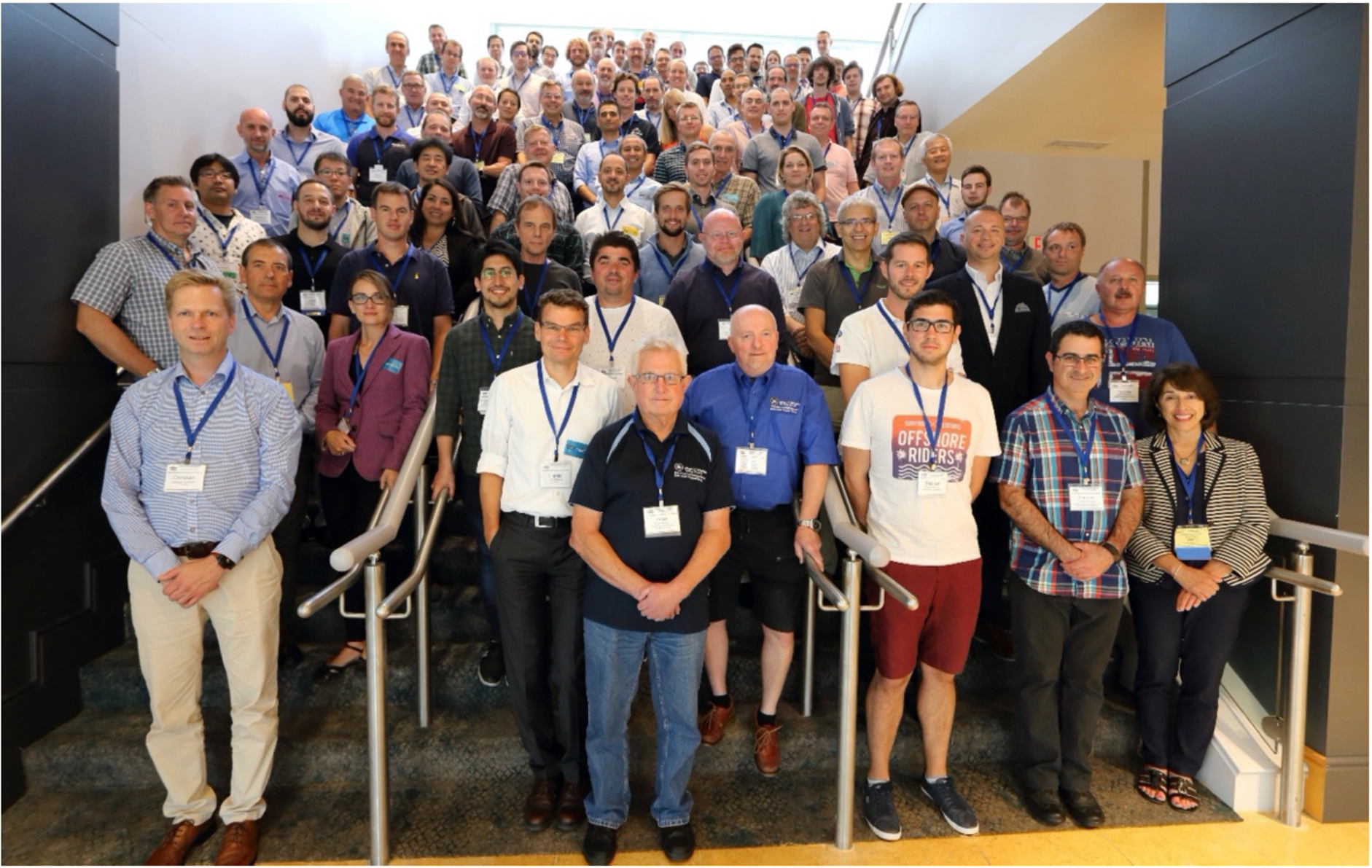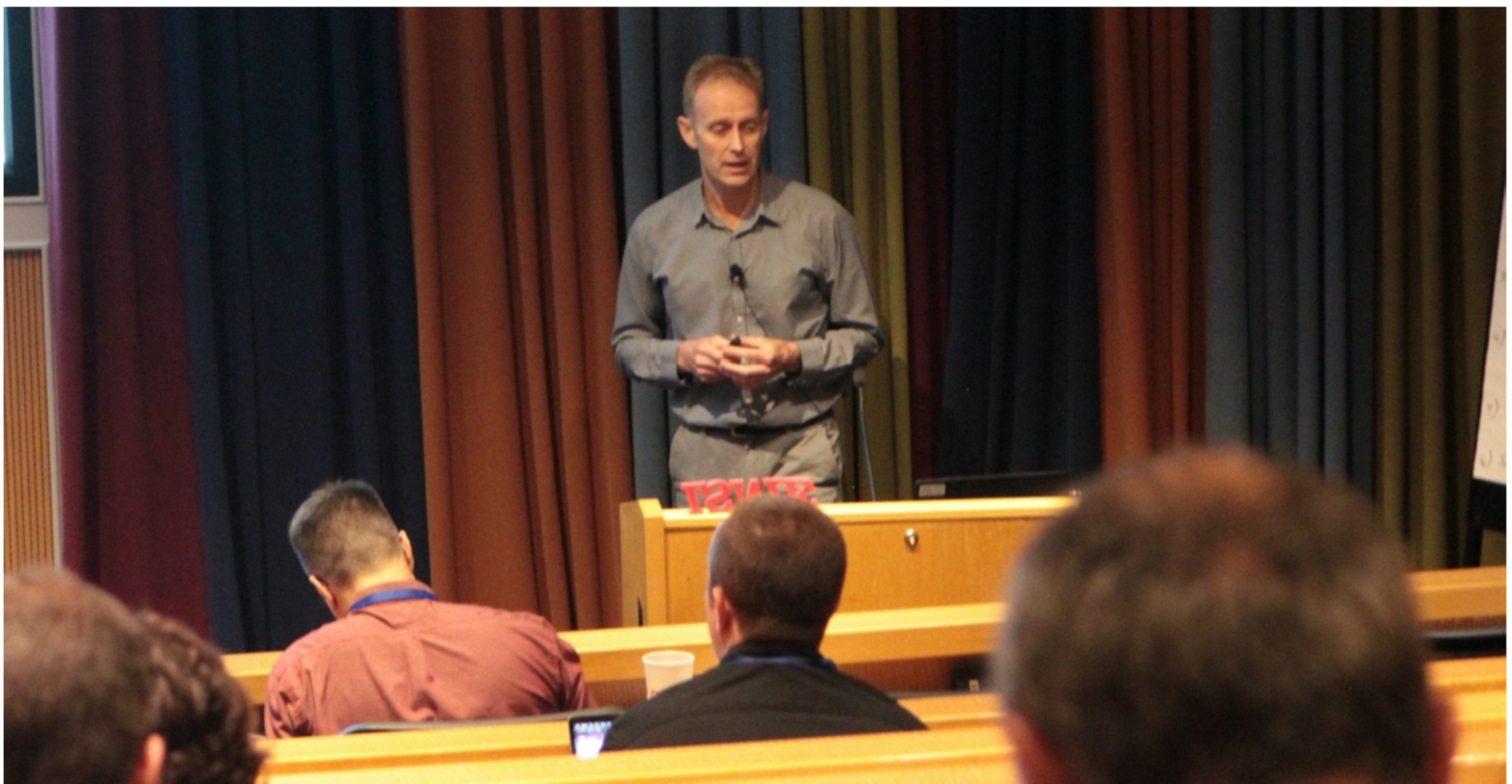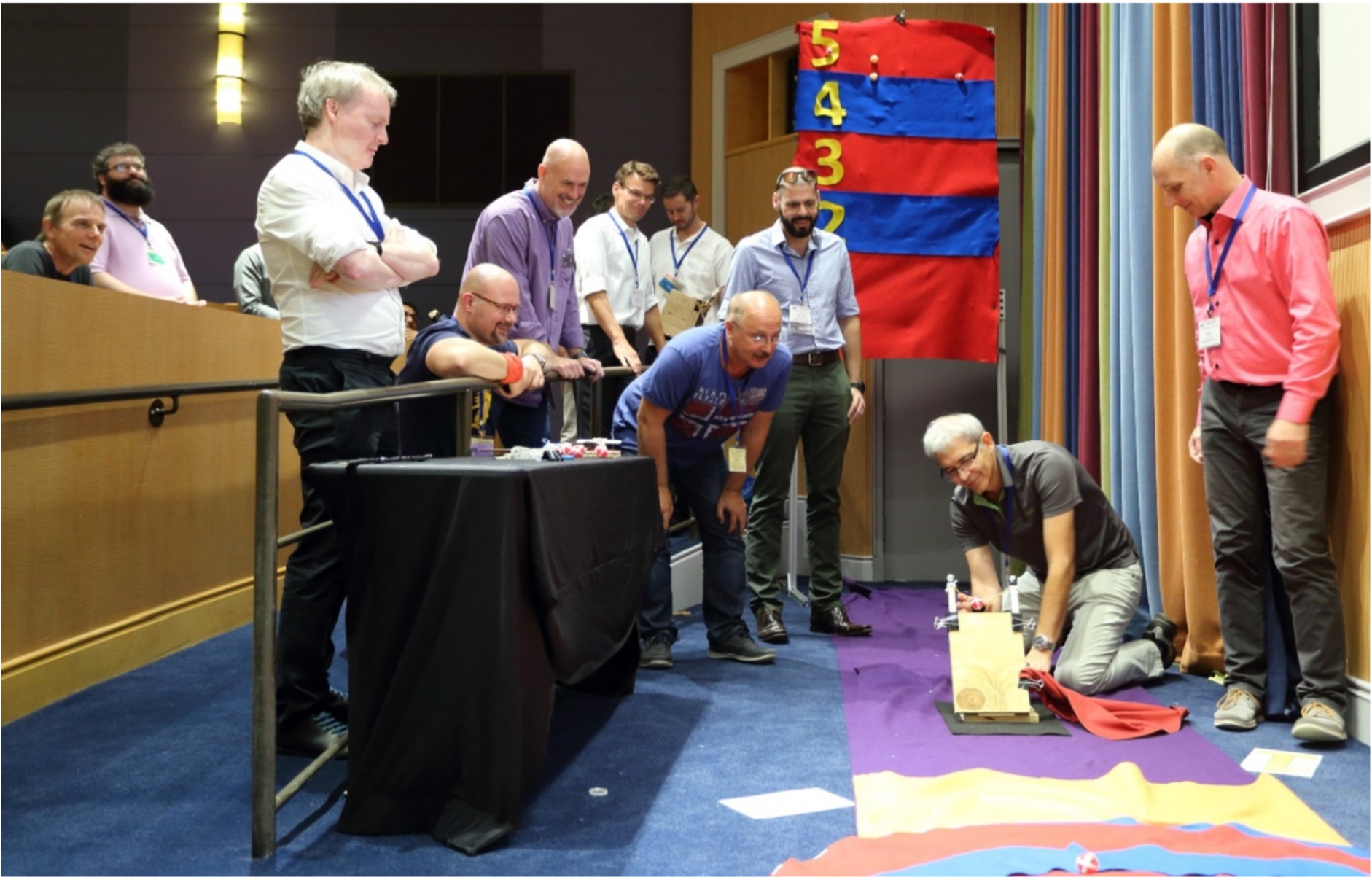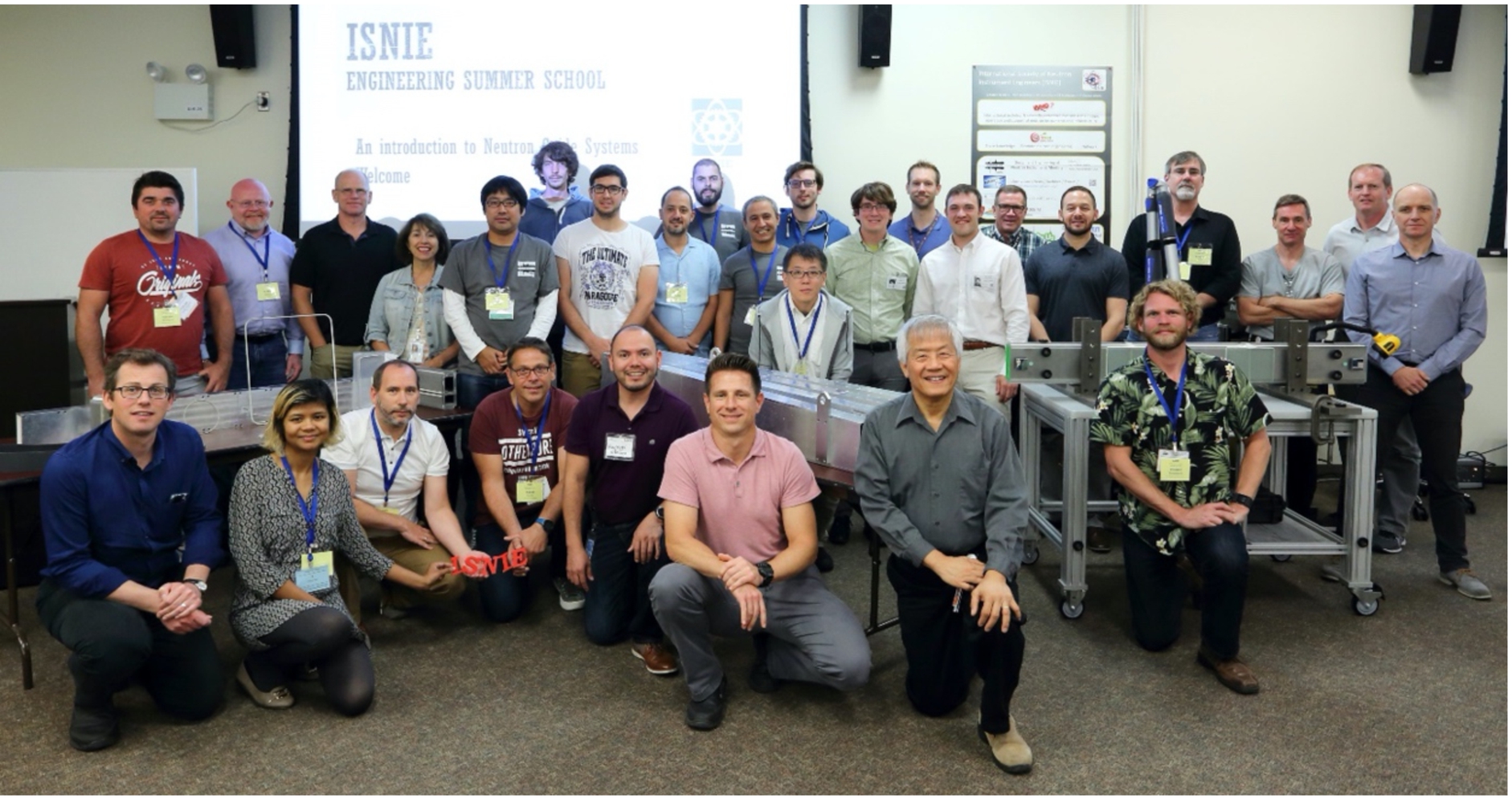8th Design and Engineering of Neutron Instruments Meeting in North Bethesda Maryland, USA 17–19 September 2019
Abstract
We present a summary description of the 8th annual international Design and Engineering of Neutron Instruments Meeting (DENIM) which was held in North Bethesda, MD, USA, September 17–19, 2019. DENIM VIII was organized by the National Institute of Standards and Technology (NIST) Center for Neutron Research (NCNR) in combination with the University of Maryland (UMD). DENIM specifically addresses the unique field of neutron instrument engineering, a subcategory of neutron scattering science. DENIM is organized by engineers for engineers who share openly about what works and what doesn’t work in the life cycle design of an instrument used to analyze materials with neutrons. DENIM is held under the patronage of the International Society of Neutron Instrument Engineers which was formed in 2017. At DENIM VIII, there were 3 keynote talks, 29 additional presentations and 13 posters (presented to the plenary in a poster slam session). Attendees toured the unique labs at NIST including the NCNR. Four parallel knowledge sharing sessions helped attendees explore mutual challenges and solutions in the areas of Instrument Installation Survey and Alignment, Electrical Grounding, Choppers and Velocity Selectors, and 3D Printing.
The 8th annual international Design and Engineering of Neutron Instruments Meeting (DENIM) [5] was held in North Bethesda, MD, USA, September 17–19, 2019. DENIM VIII was organized by the National Institute of Standards and Technology (NIST) Center for Neutron Research (NCNR) in combination with the University of Maryland (UMD). DENIM is the world’s largest and most important conference about neutron instrument engineering. Motivated by the knowledge that conceptual design through installation and test of similar neutronic instruments in isolation was less efficient and effective than collaboration, DENIM was first conceived of and hosted in 2012 by the Science & Technology Facilities Council – ISIS in Oxfordshire, United Kingdom [7]. Since then, DENIM has been coordinated by seven different neutron scattering facilities worldwide [2–4,6,8]. The exciting thing about DENIM is that it is organized by engineers for engineers, a unique community within neutron scattering science.
DENIM is now held under the patronage of the International Society of Neutron Instrument Engineers (ISNIE), which was formed in 2017 so that the benefits of DENIM could be realized year-round. ISNIE promotes the general advancement of neutron instrument engineering and its application to foster innovation, excellence and best practices within worldwide neutron scattering facilities. ISNIE has over 200 members from 33 different institutes and universities, 20 countries and 16 corporations. More information about ISNIE can be found at the ISNIE website [1]. On this website, ISNIE members have access to past DENIM presentations, summer school materials, forums and more. Please note that corporate members are restricted from some society resources.
Fig. 1.
Participants of DENIM VIII – photo by Yiming Qui (NCNR).

More than 125 people from 15 countries attended DENIM VIII 2019 (Fig. 1). Outreach efforts included North American Universities with known neutron sources and instruments. Disappointingly, there was only one attendee from a local university (UMD) who also presented though a few more did join ISNIE. One person from another United States university withdrew his registration due to lack of funding so this may have been a problem for others. For the third year running, the International Atomic Energy Agency (IAEA) financed expenses for attendees from qualifying countries in need of support, which this year included two from the National Centre for Nuclear Energy, Sciences and Techniques (CNESTEN) in Morocco and one from the Comisión Nacional de Energía Atómica (CNEA) in Argentina.
The meeting was underpinned by 3 keynote talks relating to the workshop theme of “lessons learned” and their application to future endeavors. Dr. Rob Dimeo, the Director of the NCNR, opened the conference with a very creative one-page Sketchnote to share knowledge about the NCNR and some of its unique approaches, especially regarding instruments analyzing a polychromatic neutron beam. Next, Iain Sutton from the European Spallation Source (ESS) urged the community to collaborate in his talk entitled “Still Learning, Please Pass (on!)”, and the importance for individuals to network, exchange and build on each other’s ideas thereby reaping benefits for both individuals and the community. Finally, Richard Ibberson (Fig. 2) from Oak Ridge National Laboratory (ORNL) gave a provocative and illuminating presentation about future trends and challenges in neutron scattering at the component level in terms of neutron optics, detectors, materials and technologies. Also, Richard emphasized being open to both learning from each other and from other similar industries such as Synchrotron light sources and to avoid the “not-invented-here” syndrome.
Fig. 2.
Richard Ibberson (ORNL) presenting to the plenary about future trends in neutron scattering at the component level – photo by Ed Binkley (NCNR).

There were 29 additional presentations (and 13 posters presented in a poster slam session) given to the assembly from members of the community, mostly mechanical and electrical engineers, and even a few scientists and technicians! Presenters embraced the conference theme of lessons learned and it was exciting to hear about what has worked, and more importantly what hasn’t worked on many relevant topics. In order of the number given, the talk subjects were: Mechanical Design, Project Management, Facility Development, Quality Assurance, Choppers, Mechatronics, Safety Systems, Detector Design, Lifecycle Management, and New Technology (which was how virtual reality (VR) can be used to design and test neutron instruments). In addition, a highlight of the conference was a VR demonstration created by Thibault Dupont from the Laboratoire Léon Brillouin (LLB) where attendees could tour the planned ESS facility virtually, during breaks and lunches.
The results from the 4th DENIM Knowledge Sharing breakout sessions, conducted on day two of the conference, were also very enlightening. Participants gathered in parallel sessions to brainstorm challenges and solutions in four categories: Instrument installation, Survey and Alignment, Electrical grounding, Choppers and velocity selectors, and 3D printing.
Instrument installation, survey and alignment.
Installation
Installation is understood in broadly the same terms at all facilities though requires different levels of bureaucracy to conduct.
The role of the instrument team in searching for information is seen as central.
All facilities recognize the need to consider the demands of installation at all stages of the design process.
Many people struggle to find a representative of the facility-operational stakeholder to participate both in the design process and in space-time allocations later.
Survey and Alignment
Alignment of rails in linear translation stages – use a master-slave setup.
Rough alignment in reflectometers using lasers was discussed.
Problems with alignment of objects with little access and line of site.
Buildings sink!! How to monitor alignment?
o Synchrotrons have been doing this for a long time.
o One solution is hydrostatic level monitoring systems – look to publications from the Swiss Light Source and others for this.
Electrical grounding.
Equipotential ground and protective ground within a power distribution system should be connected in one place – at the transformer.
If possible, divide the instrument into zones that are galvanically isolated, taking special care of the isolation of the detector system.
Within detector systems, it might be preferred to use power supplies that provide floating output stages (Kniel or medical grade might be purchasing options with this feature).
Within an instrument’s power distribution, all currents for all line voltages including sum current and protective grounds should be recorded so that isolation failures can be easily detected. Power Quality Analyzers are a tool for doing this (Janitza is a purchasing option).
Power Quality Analyzers need internet connection to an NTP clock, so that power disruptions can be compared between branches and systems.
Data Acquisition systems can be better protected by placing them in Faraday Cages.
The U.S. uses more power transformers and more isolated electrical branches (more copper, heat, losses), whereas European power distribution systems use fewer transformers with longer cable lengths that could end up with larger ground loops (which may result in noise issues).
At the NCNR, each instrument is electrically isolated with its own transformer.
In order to isolate data systems electrically, fiber optic data transmission may be used for short and long transmission distances.
The NCNR uses separate cable trays for routing motor cables, data cables, and sample environment cables.
Sample environment should be supplied with its own power distribution (outlets).
Choppers and velocity selectors.
Standardized chopper designs are possible but difficult due to varying scientific requirements along with their development often being driven by the scientists. Engineering of choppers is reactive, not planned. Control and monitoring systems can be standardized.
Standardizing high vacuum design features is suggested in terms of seal types, surface finishes, O-ring materials, avoiding trapped volumes, etc., to facilitate the learning curve of design engineers, especially since this may not be a strength of chopper manufacturers.
The general trend is for larger and faster discs. Disc size and speed define material choices. Development of new materials and processes is happening at various neutron facilities but is limited due to lack of time. Some facilities are investigating a range of boron coating options.
The resolution specified for translating chopper discs is often more restrictive than it needs to be. In addition, the chopper disc position is often a ratio so the inaccuracies in position can sometimes be improved by changing the phase relationship between discs after installation.
ORNL has looked at remote handling of choppers, and ESS is considering this as well, but ORNL has seen problems due to parts sticking. The consensus is that it is easier to remove choppers manually (if safe to do so).
Chopper electronics are being tested for dose-to-failure at ANSTO for use in future designs. There is also a concern about chopper sensors (vacuum, temp, etc.) and how reliable they are under high dose. Testing is needed on specific parts, but discs are prone to damage with high speed choppers, so caution is advised.
Extra monitoring sensors, for example accelerometers, can be fitted to the chopper assembly and mount to help diagnose mechanical problems as early as possible. Common reasons for failure are vibration through mounts (often caused by incorrect installation or problems with the floor and attachment method) and electrical components.
It’s important to test everything when purchased from the manufacturer including spare parts which are often needed urgently. Spare composite discs can absorb moisture while in storage which must be removed before use, as balance and geometry can change significantly. Can manufacturers test levitating bearing drives remotely and would facilities allow this?
So far, the ESS style horizontal split has not caused any issues with balance (due to varying geometry and stiffness) when swapping between maintenance and operational lower enclosures.
The best practice during downtime is to levitate bearings during maintenance cycles to prevent damaging spindles, etc. from external vibration for magnetic bearing choppers. Also, avoid powering magnetic bearings on and off where possible, as that’s the most likely time for problems to occur.
ORNL analyzes the housing strength and mount in the event of a catastrophic disc failure and the group agreed that the safety of this scenario is affected by the proximity to personnel and the type and speed of the disc. Jülich has done destructive testing in this area.
The only known injury was in 2005 at a supplier that didn’t have shielding in place, most facilities now have test areas that place the chopper inside a 10 mm steel housing. ORNL has gone to 19 mm (3/4”) Lexan to allow visual inspection during testing.
Some facilities allow the supplier to remotely log in and access the status of the chopper.
3D printing.
The main applications to date for neutron instrument engineering are collimators and background shielding.
Different styles of printing provide different capabilities and challenges. Most engineers are familiar with additive manufacturing but aren’t experts.
Aspect ratios and supporting features are key to proper design.
The cost drivers are material properties (enriched, not enriched), time on machine, layer thickness and resolution, handwork time and energy use for furnace.
Common problems with 3D-printed collimators are wall thickness to volume ratio, grid density, and inconsistencies from heating parts with extreme feature mismatches. Often, the design is approached as if it were standard machining and it shouldn’t be.
3D printing of Gd or Gd2O3 has been done with Fused Deposition Modeling (FDM) but with low concentrations (mostly less than 10%). It may be possible to achieve with higher quality and precision using binderjet.
Vanadium is too volatile for additive manufacturing.
Frustrations of 3D printing are lack of standards, black box manufacturing methods, overhangs, surface finishes for precision mating still need post processing, and the build volume aspect ratios (best quality print orientation for a collimator is almost always with the largest dimension in the “Z” direction, but printer build volumes are typically largest in the “X” or “Y” direction).
On a lighter note and for additional relationship building, the 4th DENIM Challenge (Fig. 3) was held during the conference. Teams were formed randomly, and the challenge consisted of building contraption(s) that would fling or lob ping pong balls with sticky tape attached at three different targets measuring height, precision, and distance – engineering fun at its best with loads of smiles and laughter in the mix!
The excursion to NIST on the third day of the conference was a big success with attendees touring the NCNR (Fig. 4) and other unique NIST laboratories. To increase networking, participants were combined from different institutes into ten tour groups. All attendees visited the NCNR and journeyed to either two or three of the following fascinating NIST labs: Emergency Response Robotics, Net-Zero Energy House, Fire Laboratory, Additive Manufacturing, Collaborative Robots, Body Armor, Automotive Light Weighting, Explosive Detection, Metrology, and Million Pound Deadweight Machine.
Twenty conference registrants chose to attend the optional satellite meeting hosted by Oak Ridge National Laboratory (ORNL) located in Oak Ridge, TN prior to DENIM on Friday, Sept. 13, which included a tour of the Spallation Neutron Source (SNS) and the High Flux Isotope Reactor (HFIR).
In addition, the second annual one day summer school (Fig. 5) was held at the NCNR and was attended by approximately twenty-five people directly following DENIM on Friday, Sept 20. The subject for summer school this year was Neutron Guides: theory, simulation, substrate selection and coatings, installation, alignment and more.
Fig. 3.
DENIM challenge – photo by Yiming Qui (NCNR).

Fig. 4.
Ed Binkley (NCNR) explaining the engineering intricacies of the Spin Echo Spectrometer at the NCNR – photo by David Anderson (ORNL).

Fig. 5.
Second annual ISNIE Summer School – photo by Yiming Qui (NCNR).

Other activities included an optional field trip (the day before the conference started) consisting of docent lead tours of the Smithsonian National Air and Space Museum located on the mall of Washington DC. That evening, the lovely September weather allowed an outdoor, rooftop Welcome Reception at Pinstripes Bistro, Bowling and Bocce (located within walking distance of the conference hotel) and several competitive games of bocce were played. The conference banquet was a lively dinner cruise on the Potomac River, affording views of historic icons such as the Washington Monument against the backdrop of a gorgeous and colorful sunset.
In light of COVID-19, the ISNIE Board was pleased to host the first ever virtual DENIM held 15th–17th, September, 2020. Virtual DENIM 2020 was a free, live, on-line, conference for two hours and 15 minutes each day. There were 209 registrants with a peak connection of 140, although the format was constrained because of the time zones. There were 14 talks and 10 posters presented at Virtual DENIM 2020, and the ISNIE Annual General Meeting was held on the last day of the conference.
Whether DENIM 2021 will be Virtual or In-person is unknown at this time, but it’s a safe bet that it will happen! Please continue to check the ISNIE website for the most recent information about DENIM.
References
[1] | |
[2] | D.C. Anderson, 6th design and engineering of neutron instruments meeting organized by ANSTO, J. Neutron Research 20: (3) ((2018) ), 43–46. |
[3] | S. Désert, P. Lavie, P. Permingeat, S. Klimko and S. Gautrot, Automatic beam stop changer, J. Neutron Research 20: (3) ((2018) ), 63–69. doi:10.3233/JNR-180062. |
[4] | P.-E. Doege, P. Zakalek, J. Baggemann, E. Mauerhofer, U. Rücker, T. Cronert, T. Gutberlet, Y. Bessler, J. Wolters, M. Butzek, S. Böhm, R. Nabbi, G. Natour and T. Brückel, Parametric study and design improvements for the target of NOVA ERA, J. Neutron Research 20: (3) ((2018) ), 47–54. doi:10.3233/JNR-180064. |
[5] | N. Hadad, D. Adler, D. Pierce, B. Ogg, D. Anderson, I. Sutton, S. Desert and S. Olsen, Design and engineering of neutron instruments meeting (DENIM) – 8th annual meeting, Neutron News 30: (4) ((2019) ), 9–11. doi:10.1080/10448632.2019.1695504. |
[6] | D. Marais, P.R. Van Heerden, C.R. Raaths, M. Lesha and A.M. Venter, Expansion of the detector bank of the Necsa neutron power diffractometer, J. Neutron Research 20: (3) ((2018) ), 71–77. doi:10.3233/JNR-180060. |
[7] | L. Perrott, Engineers meet at ISIS to discuss instrument design, Neutron News 24: (1) ((2013) ), 10–11. doi:10.1080/10448632.2013.750507. |
[8] | J.-M. Ryu, J.M. Sungil Park and B.S. Seong, Improved monochromator concrete shielding for the cold neutron triple-axis spectrometer at HANARO, J. Neutron Research 20: (3) ((2018) ), 55–62. doi:10.3233/JNR-180061. |




